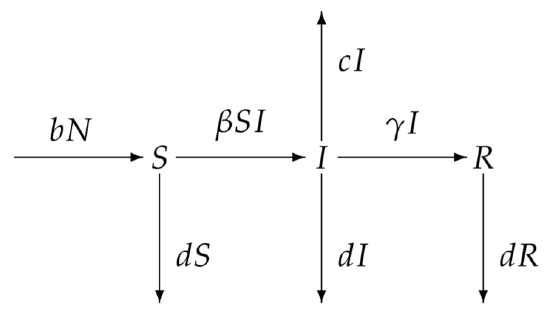4.5: The SIR Endemic Disease Model
- Page ID
- 93509
A disease that is constantly present in a population is said to be endemic. For example, malaria is endemic to Sub-Saharan Africa, where about \(90 \%\) of malaria related deaths occur. Endemic diseases prevail over long time scales: babies are born, old people die.
| Disease | Description | Symptoms | Complications |
|---|---|---|---|
| Diphtheria | A bacterial respiratory disease | Sore throat and lowgrade fever | Airway obstruction, coma, and death |
| Haemophilus influenzae type b (Hib) | A bacterial infection occurring primarily in infants | Skin and throat infections, meningitis, pneumonia, sepsis, and arthritis | Death in one out of 20 children, and permanent brain damage in 10% - 30% of the survivors |
| Hepatitis A | A viral liver disease | Potentially none; yellow skin or eyes, tiredness, stomach ache, loss of appetite, or nausea | usually none |
| Hepatitis B | Same as Hepatitis A | Same as Hepatitis A | Life-long liver problems, such as scarring of the liver and liver cancer |
| Measles | A viral respiratory disease | Rash, high fever, cough, runny nose, and red, watery eyes | Diarrhea, ear infections, pneumonia, encephalitis, seizures, and death |
| Mumps | A viral lymph node disease | Fever, headache, muscle ache, and swelling of the lymph nodes close to the jaw | Meningitis, inflammation of the testicles or ovaries, inflammation of the pancreas and deafness |
| Pertussis (whooping cough) | A bacterial respiratory disease | Severe spasms of coughing | Pneumonia, encephalitis, and death, especially in infants |
| Pneumococcal disease | A bacterial disease | High fever, cough, and stabbing chest pains, bacteremia, and meningitis | Death |
| Polio | A viral lymphatic and nervous system disease | Fever, sore throat, nausea, headaches, stomach aches, stiffness in the neck, back, and legs | Paralysis that can lead to permanent disability and death |
| Rubella (German measles) | A viral respiratory disease | Rash and fever for two to three days | Birth defects if acquired by a pregnant woman |
| Tetanus (lockjaw) | A bacterial nervous system disease | Lockjaw, stiffness in the neck and abdomen, and difficulty swallowing | Death in one third of the cases, especially people over age 50 |
| Varicella (chickenpox) | A viral disease in the Herpes family | A skin rash of blister-like lesions | Bacterial infection of the skin, swelling of the brain, and pneumonia |
| Human papillomavirus | A viral skin and mucous membrane disease | Warts, cervical cancer | The 5-year survival rate from all diagnoses of cervical cancer is 72% |
Let \(b\) be the birth rate and \(d\) the disease-unrelated death rate. We separately define \(c\) to be the disease-related death rate; \(R\) is now the immune class. We may diagram a SIR model of an endemic disease as

and the governing differential equations are
\[\frac{d S}{d t}=b N-\beta S I-d S, \quad \frac{d I}{d t}=\beta S I-(d+c+\gamma) I, \quad \frac{d R}{d t}=\gamma I-d R \nonumber \]
with \(N=S+I+R\). In our endemic disease model, \(N\) separately satisfies the differential equation
\[d N / d t=(b-d) N-c I \nonumber \]
and is not necessarily constant.
A disease can become endemic in a population if \(d I / d t\) stays nonnegative; that is,
\[\frac{\beta S(t)}{d+c+\gamma} \geq 1 \nonumber \]
For a disease to become endemic, newborns must introduce an endless supply of new susceptibles into a population.


